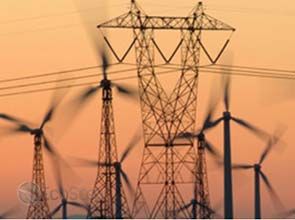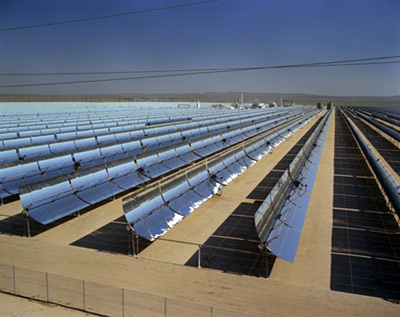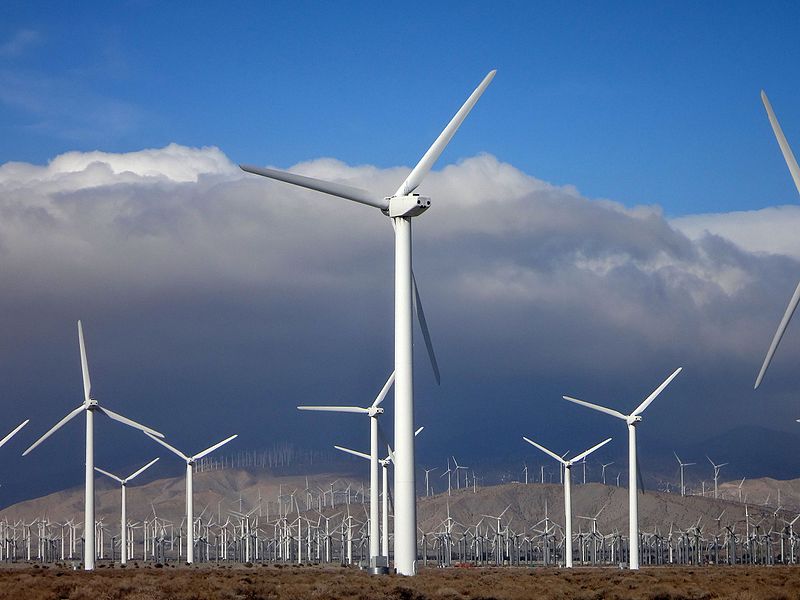
Power transmission lines. (Photo: Wikipedia)
Energy Fragmentation Resulting in Blackouts Says PG&E
100% green power target percentages are mandated under 2018 bill
By Wayne Lusvardi, September 9, 2020 10:33 am

California’s fragmented energy system has resulted in not enough local or imported power to rescue California from blackouts, not due to deregulation or privatization, energy trading, technical breakdown or error, or natural events, just as in 2001.
On November 7, 2019, the California Public Utilities Commission (CPUC) issued Decision D. 19-11-016, ordering extensions on licenses of older natural gas power plants, scheduled to be retired by December 31, 2020 with a capacity of 4,800 megawatts; and procurement of 3,300 megawatts from unspecified new power plants by 2023. The purpose of the order was to address anticipated electricity shortages in 2020.
But by mid-August 2020, the above actions were not completed to meet the demands of a heat wave resulting in rolling blackouts. Some of the first reports were that the cause of the blackouts had “experts stumped.” Gov. Newsom ordered an investigation into the root cause of the power deficiency that resulted in rolling blackouts.
Two weeks later on Labor Day weekend Newsom had to issue an emergency order overriding the CPUC and private and public utilities to start up mothballed natural gas power plants to meet the demands of another hot spell (e.g., Alamitos, Huntington Beach, Redondo Beach, Ormond Beach power stations). Even though these older power plants were re-started, by September 6, California’s power grid operator had to call for customer conservation or 3 million Californians could suffer blackouts.
Parenthetically, these same gas power plants were what the California 2001 Energy Crisis was mostly about. At that time there were over a dozen diesel-fueled power plants that under energy deregulation had to be sold by PG&E, SDG&E and Edison, to merchant power companies and converted to cleaner natural gas power plants. This was done to meet federal EPA air quality standards or California would lose federal highway and education funds.
California didn’t have enough power during this transition.
However, the public can understand some of the reasons for the recent blackouts by reading the September 1 filing with the CPUC of Pacific Gas and Electric’s (PG&E’s) Integrated Resource Plan (IRP).
Every two years regulated electric utilities in California are required to file with the CPUC a report indicating what progress they are making toward:
- 50 percent green power by 2026,
- 60 percent by 2030 and
- 100% by 2045
The above target percentages for green power are mandated under California Senate Bill 100 enacted in 2018 (100 stands for 100% green power). These reports are called Integrated Resource Plans because they show how electric utility plans to “integrate” a mix of conventional power and green power sources to meet green energy goals, including retiring existing power plants and building new plants.
Planning and Market Fragmentation
PG&E’s 2020 IRP report describes the situation that caused electricity shortages as fragmentation. According to PG&E, “California’s expansion of retail choice—driven by growth in —
- Distributed Generation (DG or rooftop solar),
- the expansion of Community Choice Aggregators (CCAs-local city and county green power cooperatives), and
- Direct Access reopening (DA or customer choice by involuntary enrollment)”;
- resulted in considerable fragmentation to long-term electric sector planning (p.3).
The three monopoly power providers (PG&E, SDG&E and Edison) were decentralized by adding 21 local Community Choice Energy agencies with 10 more pending approval, resulting in a “fragmented marketplace.”
PG&E singles out newer Community Choice Energy agencies as complicating the planning process (p.7). Regulatory authority over CCA’s is divided between the CPUC and the respective municipalities of each CCA. To add to the governmental fragmentation, the State Water Quality Control Board on Sept. 1 approved extending the lives of the four coastal gas power plants.
Jim Phelps, a utility engineer in Marin County, stated in an email: “the only way the CPUC can compel CCA’s to buy more gas power for emergencies is if the Resource Adequacy (RA) formula is changed, and that flows through the CPUC. CCA’s are also governed by municipal stakeholders and Joint Powers Authority members.”
The CPUC didn’t begin to regulate CCA’s until 2018. But that hasn’t been totally effective. Steve Berberich, CEO of Cal-ISO, has said that CCA’s were ordered to procure additional gas power in 2019 for anticipated shortfalls in 2020, but instead pursued battery storage.
California wants to shift to hybrid solar-battery power plants, but the solar plants would have to be in the desert and the batteries located near customers in a distributed (local) grid.
But where would be the backup for unreliable solar power? This would entail fragmented microgrids but how would the grid operator assure reliability and where is the CPUC plan for microgrids? The CPUC may flip these microgrids to Community Choice Energy agencies, but many cities already want out of CCA’s because of the higher costs of power than from PG&E or Edison (City of Dixon, Palos Verdes Estates, San Luis Obispo County, Rancho Palos Verdes).
Intended Policies
What the CPUC filing by PG&E indicates is that the recent rolling blackouts occurring during the recent heat wave are not due to a cascading failure of the system, wind or fire damage to transmission lines, circuit breaker failure, transformer failures or lightning. Neither is it a deficiency of enough solar and wind power to meet the early peak hour demands (9 am to 6 pm). In fact, California often has to pay other utilities to take its excess solar power late in the day.
Nor are blackouts necessarily due to reliance on imported power from other states because it was imported natural gas and coal power that kept Southern California free of rolling blackouts.
But that power was procured by long-term contracts, not in the daily spot market. Not enough spot market power from nearby states was available during the heat wave for some parts of California because those other states had also shifted to solar power and needed to retain their natural gas and coal power to meet their own needs during sunset hours. Southern California especially needs to rely on imported power to meet air quality mandates but has done so through long-term power contracts.
California’s grid operator – Cal-ISO – had been warning of the probability of rolling blackouts for some time because there is a deficiency in fast dispatching power plants. But even Cal-ISO may have been surprised that the regional Western Energy Imbalance Market they created in 2014 for backup power failed to have enough capacity to export power to California during the hot spell. The spread of solar power to nearby states has diminished any quickly dispatchable power for export to California.
The spread of green solar power by California’s Global Warming Solutions Act of 2006 (AB 32) to other states has brought about the intended consequence of not enough local peaker power plants and imported power and accompanying blackouts, not deregulation or privatization, energy trading, technical breakdown or error, or natural events, just as in 2001.
- Peter Gleick’s National Water Plan for California - October 12, 2020
- Court Opens Up Big Prop.13 Loophole for ‘Public Franchise Fees’ - October 2, 2020
- New Cal Grid CEO is Ex-Enron Green Power Trader - September 29, 2020




California’s Dysfunctional Electricity Policies may lead to more Blackouts – Shuttering of in-state power plants, “leaks” the generation and emissions to other states. As a result of California’s intermittent electricity from wind and solar being unable to provide continuous uninterruptable electricity in-state, California imports more electricity than any other state as a result of “leakage” to other states from them to generate emissions for the generated electricity needs of California. At the same time, the states “green” religion remains adamantly against in-state coal, natural gas, nuclear, and hydro power plants. Can you see the conundrum the state is in? https://www.foxandhoundsdaily.com/2020/08/californias-dysfunctional-electricity-policies-may-lead-to-more-blackouts/
Mr. Stein
California, especially Southern California, HAS to import power from other states to meet its air quality mandates. Unlike other states, California is a Basin State with smog traps. Other states are Plains States where the wind dissipates any emissions from cars or power plants. So, California exports it smog and imports its electricity. But solar power is self limiting and unsustainable in the long run as California is just now finding out. California set up an Energy Balancing Market in 2014 to buy imported power during the daily energy crisis at sunset as the sun fades out. The Balancing Market also provides extra power during heat waves and cold snaps. But nearby states no longer have enough gas and coal power to sell to California because, like California, they have switched to solar power and need dispatchable gas power for their own needs. To repeat, solar power is self-limiting. The CPUC wants to dismantle the power grid and form utopian micro-grids powered by solar farms with battery storage. But what backs up the highly variable solar power? And batteries are a non-solution for 40 million people. When time-of-service pricing (real time pricing) starts to be implemented power will cost, what, $1 to $10 per kilowatt hour? This is meant to drive people to signing up for solar panels. But as the grid becomes dependent on all-electrified power sources instead of a diverse mix of gasoline, natural gas, coal power, nuclear, hydro and green power, the entire economy will be blacked out at the same time. The regional power grid is balkanizing while California is socializing but the CPUC and Cal-ISO are just now finding that out.
Thank you for confirming my recent decision to abandon this dystopian state (for the second time) and maybe return for vacations, assumimg it’s worth visiting….
Liberalism is truly a mental disorder and we have a majority of mentally ill people elected to leadership in this state…